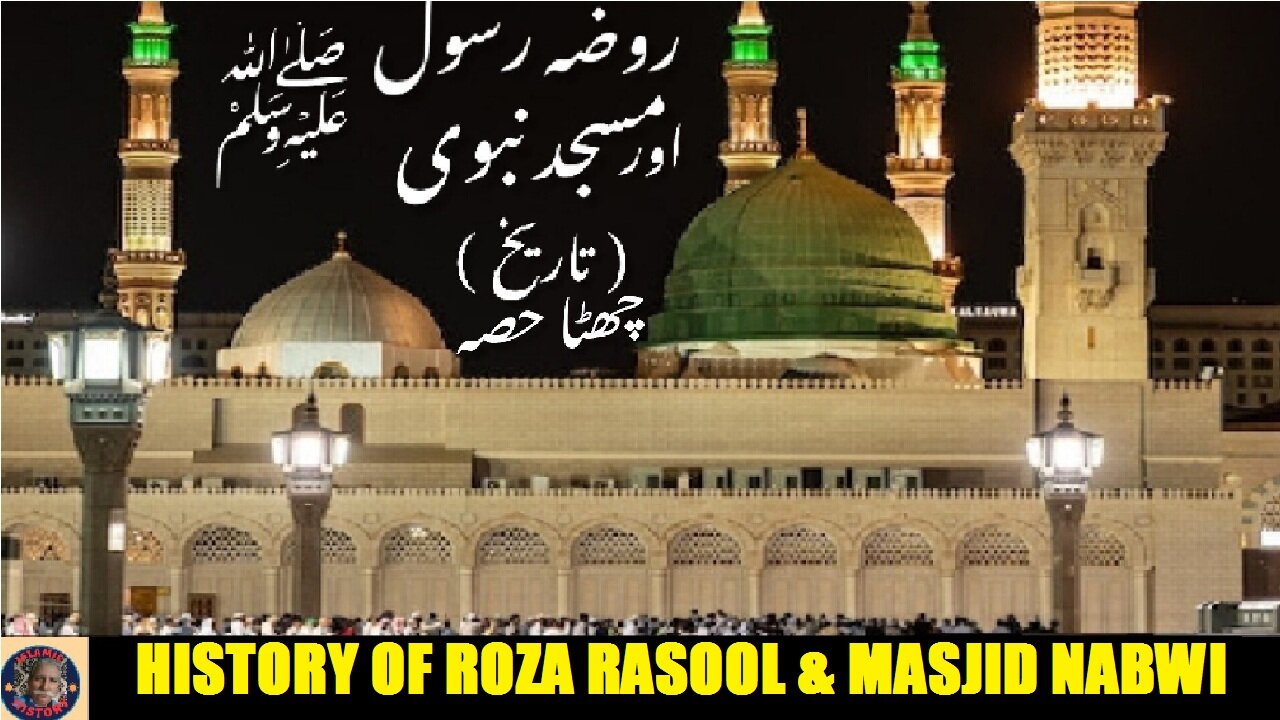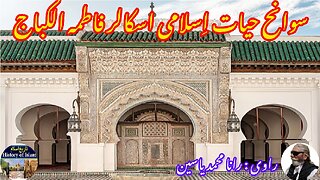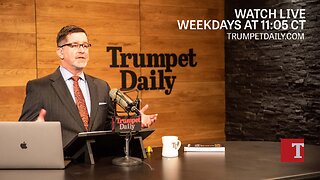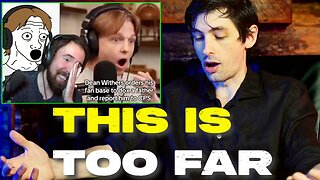Premium Only Content

Part-6 History of Roza Rasool and Masjid Nabwi روضہ رسول اور مسجد نبوی صلی اللہ علیہ وسلم کی تاریخ
@islamichistory813 #TombOfTheProphetMuhammad #SacredChamber #IslamicHistory #Madina
Part-6
History of Roza Rasool and Masjid Nabwi (Peace be upon Him)
Asslamoalaikum sisters brothers friends and elders, We are contineu going to start describing from where yesterday we was stop describing the Tomb (Roza Rasool) of the Prophet Muhammad SAW (The Sacred Chamber, its is sisxth part of topic.
The Burial Site
After the demise of the Prophet ?, a disagreement arose about where he should be buried. Some of the Muhajirun (emigrants) suggested that he should be buried in his hometown of Makkah, where his relatives were. Others suggested that he ought to be buried in Jerusalem, where preceding prophets had been interred. However, this was very impractical as Jerusalem was in the hands of the Byzantines, who were hostile towards Muslims.
The companions soon came to an agreement to bury him in Madinah, although they were unsure about the location of a burial site. Some suggested he should be buried in Masjid Nabawi, where he preached, spoke to, and led the people. A site at or next to his minbar was advocated, but this idea was rejected. Others said he should be buried in Jannatul Baqi. Abu Bakr al-Siddiq I, who had just been made the first Caliph of Islam, solved the conundrum by mentioning he heard the Prophet ? say that prophets should be buried where they die. Upon hearing this, the furniture inside Aisha’s J house was removed in preparation for the burial, which was to be carried out directly beneath the Prophet’s ? bed.
Washing the Blessed Body
Ghusl of the blessed body of the Prophet ? was carried out by various family members: his cousin and son-in-law, Ali ibn Abu Talib, his uncle, al-Abbas ibn Abd al-Muttalib and al-Abbas’ two sons, al-Fadl and Qutham M. The Prophet’s ? servants, Usamah ibn Zayd and Shuqran L also participated.
Al-Abbas, al-Fadl and Qutham were responsible for turning the blessed body whilst Usamah and Shuqran poured water over it. Ali washed the body. They were very careful not to expose the blessed body of the Prophet ?, who was covered in a gown whilst the ghusl took place.
During the ghusl, beautiful scents emanated from the sanctified body of the Prophet ?, just as they did during his life. Ali remarked: “O Messenger of Allah, how sweet and pure you are, both in life and death!” After the ghusl, three white garments from Yemen were used to shroud the blessed body of the Prophet. Two of these garments were made in the village of Sahul, and the third was made in Hibarah.
The community was then permitted to see the Prophet’s ? blessed body. Companions flooded through the door of Masjid Nabawi to see him and to pray for him.
The Funeral Prayer
Abu Bakr and Umar L entered the room and joined those companions who were already performing the Janazah salah (funeral prayer). Since the room was limited in size, companions came in small groups (ten by ten) before leaving to allow the next group in. There was no imam to lead the prayer. The first to pray for the Prophet ? were members of his clan, who were followed by the Muhajirun, then the Ansaar. After the men had carried out the prayer, women and children were permitted to enter to see the Prophet ? for the last time. Nobody emerged from the room except that they were filled with grief, indescribable sorrow and worry for the future of the community. People continually arrived to see the Prophet ? throughout Tuesday and the best part of Wednesday.
The Burial
When it came to the actual burial, there was a difference of opinion between the companions of how the Prophet ? should be buried. At the time, there were two primary ways in which graves were dug:
The Madinans preferred to excavate into the ground and dig a niche into the side of the earth, typically in the direction of the Qibla, so that the grave would be “L-shaped”. The body would then be laid in the niche, and the opening would be covered with bricks. Earth would then be thrown into the open space within the grave, avoiding the body. This method is known as “Lahd” (Arabic: ?????) and is the sunnah method of burial according to the majority of Sunni schools of thought.
The Meccans preferred to excavate in the middle of the grave, laying the body on its right side in a hole dug at the bottom. A platform would then be placed above the body in the grave. This method is known as “Shaqq” (Arabic: ????) and is the preferred method of burial according to the Hanafi school of thought.
Two companions who were adept at digging graves were sent for – Ubaydah ibn al-Jarrah I, a Meccan, and Abu Talha al-Ansari I, a Madinan. However, Ubaydah couldn’t be found, so Abu Talha was given the responsibility of digging the grave of the Prophet ?. Abu Talha dug the grave in Aisha’s hujra under the bed in which the Prophet ? was resting. He did so in the Medinan way. Aisha J narrates:
When the Messenger of Allah ? died, they differed as to whether his grave should have a niche or a ditch in the ground until they spoke and raised their voices concerning that. Then Umar said: ‘Do not shout in the presence of the Messenger of Allah ?, living or dead,’ or words to that effect. So they sent for both the one who made a niche and the one who dug graves without a niche, and the one who used to make a niche came and dug a grave with a niche for the Messenger of Allah ?, then he ? was buried.17
On Wednesday, as nightfall descended and the companions reluctantly and dejectedly parted ways with the blessed body of the Prophet ?, the relatives of the Prophet ? prepared for his burial. After a quarter or a third of the night had passed, Ali ibn Abi Talib, al-Fadl ibn al-Abbas and Qutham ibn al-Abbas, along with Shuqran M, lowered the Prophet ? into his resting place. Abu Laila I, who wasn’t a relative of the Prophet ? is also reported to have taken part in the burial after getting permission from Ali I. After some earth had been laid over the blessed body, Shuqran I, the freed slave of the Prophet ?, took a red mantle that the Prophet ? used to wear and buried it in the grave. A bridge was built with bricks, then the grave was covered with sand.
So dear friends, remaining history will be described from here in next video part-7. Allah Hafiz
======================================
-
 7:57
7:57
ISLAMIC HISTORY
28 minutes agoIslamic Women Scholar Fatima Al-Kabbaj फातिमा अल-कब्बाज فاطمہ الکباج کی سوانح حیات
3 -
 LIVE
LIVE
Grant Stinchfield
46 minutes agoThe War on Real Food... How Corporate Giants Hijacked Your Dinner Plate
107 watching -
 LIVE
LIVE
Trumpet Daily
38 minutes agoTrumpet Daily LIVE - July 29, 2025
495 watching -
 LIVE
LIVE
JuicyJohns
4 hours ago $1.47 earned🟢#1 REBIRTH PLAYER 10.2+ KD🟢 !loadout
112 watching -
 DVR
DVR
Bannons War Room
5 months agoWarRoom Live
30.3M7.45K -
 8:36
8:36
Warren Smith - Secret Scholar Society
1 day agoTikTok's Biggest Political Star Goes Too Far & Blows Up His Own Career
7.59K11 -
 56:42
56:42
VSiNLive
2 hours ago $0.65 earnedA Numbers Game with Gill Alexander | Hour 1
7.99K -

The Big Mig™
4 hours agoAct Blue, Magic Mortgage Money Laundering Scheme
5.03K2 -
 2:03:57
2:03:57
Matt Kohrs
11 hours agoMARKET OPEN: Stocks Rocket, Trade War News & Earnings Season || Live Trading
24.5K2 -
 1:25:02
1:25:02
Dear America
4 hours agoHere’s EVERYTHING We Know About The “White” NYC Shooter… + Trump Secures MAJOR Deal With EU!!
140K114